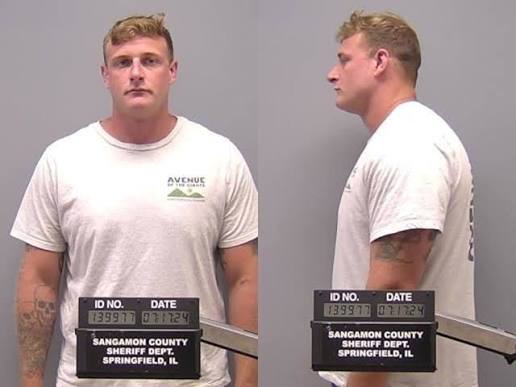sonya massey shooting: what happened to the cop that shot,case update

A prosecutor says an Illinois sheriff’s deputy had no legal justification for shooting Sonya Massey in her home in July 2024. Today we will discuss about sonya massey shooting: what happened to the cop that shot,case update
sonya massey shooting: what happened to the cop that shot,case update
On July 6, 2024, 36-year-old Sonya Massey, a Black woman and mother, was fatally shot inside her home in Springfield, Illinois, after she had called 911 for help. The officer involved, Sangamon County deputy Sean Grayson, was later indicted for murder. This tragic incident has sparked national outrage and reignited conversations surrounding race, mental health, and police use of force in the United States.
This comprehensive report explores the night of the incident, the criminal case against the officer, the legal and social repercussions, and what this case could mean for the future of policing in America.
What Happened the Night Sonya Massey Was Shot?

The 911 Call
At approximately 12:49 a.m., Sonya Massey placed a 911 call reporting that she believed someone might be outside her home. She was reportedly concerned about noises and potential trespassers. Two deputies from the Sangamon County Sheriff’s Office responded to her call — one of them was 30-year-old deputy Sean Grayson.
Upon arrival, the deputies searched the exterior of Massey’s residence but found no signs of forced entry or intruders.
Inside the Home
Massey invited the officers into her home, where the encounter appeared initially calm. Body-camera footage later revealed that she was cooperative, standing with her hands visible, and even said, “Don’t hurt me,” when the officers entered.
As the deputies asked for her identification and tried to assess the situation, they noticed a pot of boiling water on the stove. One of the officers expressed concern, saying they didn’t want a fire while they were in the home.
Massey walked toward the stove and reportedly said, “I rebuke you in the name of Jesus.” At this point, Deputy Grayson drew his firearm and pointed it at her, shouting aggressively, “You better not or I swear to God I’ll shoot you in your face.”
Massey apologized and ducked behind the counter. The officers yelled commands for her to drop the pot. Moments later, Grayson advanced, firing three shots. One of the bullets struck Massey in the face, killing her.
Aftermath and Medical Response
After the shooting, one deputy can be heard saying, “I’m going to get my kit,” referring to first-aid supplies. Grayson responded, “You can get it, but that’s a headshot… there’s nothing we can do.”
Massey was transported to a nearby hospital but was pronounced dead shortly after arrival. An autopsy confirmed that a bullet had entered below her eye, passed through vital areas including her carotid artery, and exited the back of her neck. There was no evidence of close-range soot or gunpowder residue, indicating the shot was fired from a distance.
Who Was Sean Grayson? The Cop Who Shot Sonya Massey
Background and Record
Deputy Sean Grayson had a turbulent history in law enforcement. Between 2020 and 2024, he worked at six different police departments in Illinois — a red flag to some observers about his suitability for policing.
Prior to becoming a law enforcement officer, Grayson served in the U.S. Army, where he faced disciplinary action. He had two DUI convictions in 2015 and 2016 and was discharged from military service for “serious misconduct.”
Despite his troubled record, he managed to gain employment with the Sangamon County Sheriff’s Office, raising questions about hiring practices and background checks in law enforcement agencies.
Termination and Indictment
Shortly after the shooting, Grayson was placed on administrative leave and subsequently fired from the Sheriff’s Office. His body camera had not been activated at the time of the shooting, only being turned on afterward — a violation of protocol.
By late July 2024, a grand jury indicted him on:
-
Three counts of first-degree murder
-
One count of aggravated battery with a firearm
-
One count of official misconduct
He pleaded not guilty to all charges and is currently being held in custody without bond.
Legal Case Update: Where Things Stand Now
Criminal Trial
Grayson’s trial was moved to Peoria, Illinois, due to the high-profile nature of the case. A jury of 12 was seated — eight women and four men. Prosecutors have presented the case as a clear example of unjustified deadly force.
Grayson’s defense is built around the claim that Massey approached him with a pot of boiling water and he feared for his safety. The prosecution argues there was no lethal threat and that the use of deadly force was excessive, unnecessary, and a violation of department policy.
Key issues in the case include:
-
The officer’s failure to activate his body camera.
-
His aggressive threats before the shooting.
-
The decision not to render aid afterward.
Civil Case and Settlement
In February 2025, Sangamon County reached a $10 million settlement with the Massey family. The family’s legal team, led by civil rights attorney Ben Crump, emphasized that while the financial compensation is meaningful, it does not equate to justice or accountability.
The family has continued to demand full criminal accountability and broader police reforms to prevent similar tragedies.
Who Was Sonya Massey?
Sonya Lynaye Wilburn-Massey was a 36-year-old mother, beloved by her family and community. According to relatives, she had been managing paranoid schizophrenia and was actively seeking help the night of her death. Her call to 911 stemmed from fear, not aggression, and she had no criminal record.
Her death left behind children, grieving parents, and a community questioning how someone seeking protection could end up being killed in her own home by the very people she trusted to help her.
Wider Issues: Policing, Race, and Mental Health
Use of Force and Threat Assessment
The crux of the case lies in whether a pot of boiling water constitutes a lethal threat. Critics argue that Grayson overreacted and escalated a manageable situation. Law enforcement experts point out that proper de-escalation training could have changed the outcome.
Mental Health and Police Response
Massey’s death underscores a recurring issue in American policing — how officers respond to individuals experiencing mental health challenges. Rather than being met with compassion or a specialized response team, she encountered lethal force.
There is growing advocacy for involving mental health professionals in 911 responses, especially in non-violent situations where mental health may be a factor.
Race and Gender in Policing
Massey’s race and gender add another layer of complexity. Black women are often overlooked in conversations about police violence, even though they face unique threats both as women and as people of color.
The fact that she was killed in her own home after calling the police has led to comparisons with other high-profile cases like Atatiana Jefferson and Breonna Taylor.
Accountability and Transparency
Questions have also been raised about an initial attempt to misrepresent what happened. Early dispatch records suggested that Massey’s fatal wound was “self-inflicted” — a claim later proven false. The family alleges that they were told incorrect information in the hours after the incident, which they believe was an effort to protect the officers involved.
Policy Implications and Reform Efforts
Body Camera Policy
One of the most glaring procedural violations in this case was the failure to activate the body camera before use of force. Grayson turned his camera on only after firing three rounds. This undermines public trust and hinders transparency.
Calls have grown for laws requiring automatic body camera activation or disciplinary measures for non-compliance.
Hiring Practices in Law Enforcement
Grayson’s checkered employment history has led to scrutiny of how police departments vet potential officers. Advocates have demanded stricter background checks and centralized databases to track problematic officers across departments.
De-Escalation and Crisis Training
Another critical area of concern is the lack of adequate training in de-escalation techniques. Mental health response training remains inconsistent across police departments. More departments are being urged to implement crisis-intervention teams and alternatives to armed response.
Community Oversight
The shooting has renewed interest in creating civilian oversight boards with the power to investigate, discipline, and reform local police departments.
Public Reaction and National Attention
The release of the body-cam footage led to public outcry across social media and protests in Springfield and other cities. Activists, civil rights leaders, and celebrities joined the call for justice. President Joe Biden even addressed the incident, describing Massey as a woman who “should be alive today.”
Massey’s case has become a focal point in the national dialogue about race, police accountability, and mental health — a tragic but powerful symbol of the need for systemic reform.
What Happens Next?
Awaiting Trial Verdict
As of October 2025, the trial of Sean Grayson is ongoing. The outcome is being closely watched not just in Illinois, but nationwide. A conviction would send a strong message about accountability in policing. An acquittal would likely spark renewed protests and calls for justice.
Legislative Action
Illinois lawmakers have introduced several bills aimed at:
-
Enforcing stricter use-of-force protocols.
-
Mandating body-camera use without exception.
-
Strengthening mental health crisis response frameworks.
Whether these reforms become law will depend on continued public pressure and political will.
Ongoing Investigations
Internal investigations within the Sangamon County Sheriff’s Office continue, especially around hiring practices and training standards. The Sheriff at the time of the shooting resigned following backlash.
How useful was this post?
Click on a star to rate it!
Average rating 0 / 5. Vote count: 0
No votes so far! Be the first to rate this post.
About the Author
usa5911.com
Administrator
Hi, I’m Gurdeep Singh, a professional content writer from India with over 3 years of experience in the field. I specialize in covering U.S. politics, delivering timely and engaging content tailored specifically for an American audience. Along with my dedicated team, we track and report on all the latest political trends, news, and in-depth analysis shaping the United States today. Our goal is to provide clear, factual, and compelling content that keeps readers informed and engaged with the ever-changing political landscape.




